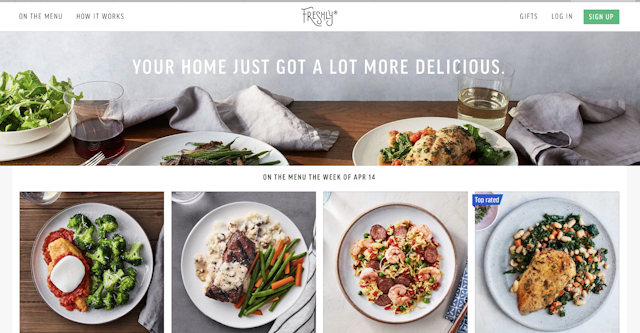A year in the life: Mayur Gutpa’s first quarter as Freshly’s CMO
One year. It can be half a tenure for some chief marketers, the beginning of a grand adventure for others. As part of The Drum’s Marketer of the Future coverage this year, we’re joining Mayur Gupta — a truly modern marketer — on his first-year journey as Freshly’s chief marketing officer.
We first spoke with Gupta this past January, when he started at Freshly, a subscription-based, fully-prepared meal delivery company focused on healthy eating. That was just the beginning. What will follow over the next 12 months is a diary that will explore everything from how Gupta reinvents the marketing team, to how he collaborates across the organization and with its agencies, to how he uses data and technology to help the company achieve its goals.
In this first installment, we look back at months one through three. Going forward, we’ll check in with Gupta monthly to track his goals and progress. We hope you’ll come along for the ride.
You’ll want to.
Gupta is a forward-thinking, data-centric marketer, whose CV highlights include vice-president of growth and marketing for Spotify, executive vice-president and chief marketing officer of Healthgrades, global head of omnichannel experiences and platforms at Kimberly-Clark, and director of marketing technology and strategy for SapientNitro. – Ginger Conlon, US editor

First quarter, three key objectives
The overarching goals for my first quarter at Freshly fell in three areas: gain a deeper understanding of the business, align marketing with Freshly’s mission, and begin to build trusted relationships.

I spent a great deal of time diving deeper into the business and its higher purpose — asking questions to validate that we're on the right trajectory, because marketing has a key role to play in helping define that higher purpose and mission. Not only did that exercise help me gain insight, but it also helped to begin building those vital relationships with my peers in the executive team and within my organization.
At the same time, I’ve been working closely with Mike [Wystrach], our founder and chief executive, to build a new blueprint for marketing to grow the brand, the user base, and the user value. We have an opportunity to demonstrate how the growth of the brand amplifies the growth of the business.
Over these first few months, I’ve been clearly articulating that we all need to hold marketing accountable for tangible outcomes and impact, and not just outputs like campaigns. This is important because, in many ways, marketing is both a service provider internally and a growth agent externally for the company.
One way we’re laying the foundation for this is by defining objective and key results for marketing. This brings visibility and shows how each person’s goals ladder up connect back with to the broader mission of the company — because nobody wants to do work that's not impacting the business. Our goal is to determine a quantitative way to demonstrate the impact of marketing by the end of 2019.
Top priorities
Obviously, the beginning of the journey will always be understanding people, the current state, the areas of strengths, and the areas that need growth and work. So, the first month was defining functions that were knocking things out of the park.
At the same time, we’re breaking down the traditional silos of marketing. We are organizing marketing not by channel but more by outcomes: creating demand, capturing demand, and retaining demand. That means, either you own a quantitative KPI and you own moving the needle on subjective or emotional and humanistic impact, or you’re responsible for building capabilities.
We’re also introducing RM, which is road manager. So, every key result has an orchestrator assigned, and the orchestrator is empowered to pull and push the levers needed to make progress toward that key result quarter over quarter.
And the beautiful thing about Freshly is we are encouraged to move fast and there is no fear of failure.
New leadership, new teams
Right now, we're hiring on a weekly basis. I'm bringing on incredible leaders who are going to tell us what needs to be done starting day one.
We’ve hired a head of PR and comms and a new vice-president of brand and creative from Grey. Our new head of content is coming on board the first week of April. At some point, we are going to hire a head of marketing technology, but it isn't as much a priority right now, because we have so much of our technology already established.
We’re in the middle of bringing on a head of consumer insights. We formed a marketing sciences organization that includes consumer insights, marketing law, marketing tech, and marketing analytics. That team will help us to understand what the users are doing off platform and why are users doing certain things on platform on the app and on our site — converging all that to create a holistic perspective on user behavior.
We’ve promoted several people into new roles and shifted other people as we’ve made changes to the organizational structure.
But one of the most important focus areas for me is horizontal teams. So, while we’re bringing top leaders who are building their vertical teams and functions, my focus is to harness horizontal teams, which is making sure there are no silos. I encourage and challenge my direct reports to make sure that each one of us is aware of what the other function is driving — where do we have to connect the dots, and how will we hold each other accountable.
Marketing is always trying to balance structure with the serendipity and creativity of marketing. So, we've established a horizontal marketing ops function with an incredible leader to create some frameworks to guide people on how to measure their own impact and their success.
Along with these changes, there are a lot of tactical things we’re doing to build trust within the marketing team. As an example, we're launching diversity and inclusion lunches in April where I will sit down with three or four members of the marketing organization with no agenda and no hierarchy to talk about life, not just work. It allows me to understand aspirations, what's not working and what's not working, and you build relationships that go beyond the work you do on a day-to-day basis.

Technology, data, and insight
Our whole business is data- and tech-driven, but within the context of marketing, the focus is on understanding the user and how that translates into the future of Freshly as an iconic lifestyle brand. We’re working to establish the core engine of marketing to communicate and engage with the end user at the right time with the right message. And we’re building an underlying content platform to deliver content that is contextual and personalized.
In terms of data and science, we’re building a consistent definition and understanding of our user base — the taxonomy; how we define the value of our user not just in financial terms, which everybody does in terms of lifetime value, but also in nonfinancial terms. Who are our most valuable users? Who are the ambassadors and influencers within our existing user base?
We’re also determining how we measure success; what are the right leading and lagging KPIs. For marketing, one of our key focus areas is how we prove the incrementality of marketing; that is, this is what marketing brought in isolation, which would not have happened in the absence of any kind of marketing. As part of that, we’re working on how we bring in elements like multi-touch activation to show the incremental impact of our performance marketing efforts.
Cross-team collaboration
I spend a lot of time with the chief technology officer and the chief product officer. One of the most inspiring things for me is relationship we’ve built in the C-suite. We are making an extra conscious effort to make sure we are not building vertical kingdoms.
I also spend a lot of time with our supply chain team to build a marketing support engine for our weekly innovation launches.
And, we’ve created cross-functional pods to hit targets in the fastest and the most effective way. We've created a growth pod that has leaders from product, engineering, and pretty much the entire performance marketing team. At some point, we may create a brand pod that will have people from product and engineering, as well, which is very unconventional. Because how are you going to grow the brand if you don't have the agility to make changes on what shows up when users are coming to your platform?
By the end of March, we’ll have a draft of what marketing at Freshly is and what everybody else at Freshly should expect from marketing, and what they should hold marketing accountable for. So, we’re doing a marketing roadshow internally in April — one, to get feedback, so we can check and adjust, and two, to empower other teams to hold us accountable for those outcomes and so they know how to best leverage marketing.
Agencies and other partners
You always need partners who share your culture, value system and purpose. We’re close to bringing new partners on board in a few areas. One is appointing a brand agency, and that is led by the brand team. We want to ensure that the Freshly brand reflects our belief system and the high purpose for the company; we’re calling it a brand rethink.
We are also working on identifying a partner to help us understand our user base, help us build an always-on engine for insights, analytics, and measurement and work with us to understand the ‘why’ behind the what the users do.
And we’ll be bringing some partners for PR and comms.
A sneak peek into April
I look at my priorities as quarterly sprints. Starting in April, the focus will be to get into execution mode, pick up the brand-rethink work, and launch our content organization. Consumers should expect to see and understand a lot more about Freshly, not just as a brand but also understanding what nutrition does to someone's life.
The focus in Q2 is getting everybody behind these things and get them along. And you don't do that by telling people what needs to be done, but by brainstorming and making them believers and not hostages.
So, that's going to be the focus. And there are, of course, some key initiatives across demand creation and demand capture, and demand attention that we're kicking off.

